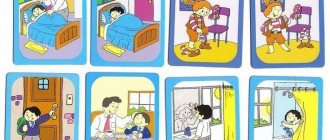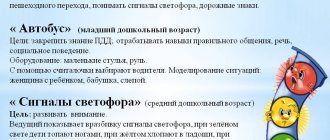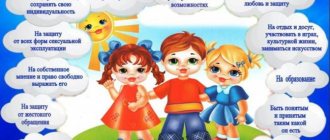Musical games for the younger group of kindergarten
Methodological development.
Musical games for younger preschoolers Author: Nadezhda Veniaminovna Zemlemerova, music director of MBDOU “Kindergarten No. 6 “Malachite” in the city of Cheboksary, Chuvash Republic.
This development will be useful for music directors and kindergarten teachers.
Can be used both in music classes and in leisure activities with younger preschoolers. Goal: Formation of motivation for musical activity; — development of musicality in children of primary preschool age. Objectives: - nurturing a child’s interest in the world of musical and non-musical sounds, elementary music-making;
- development in children of perception of musical and non-musical sounds; - enriching children's musical experience; — activation of children’s emotional reactions to music; — development of musical and game improvisations, performing skills and creative abilities in children. Junior group
“Guess the instrument” (A screen is installed, behind it there are musical instruments: bells, a drum, a rattle, a tambourine. The teacher reads a quatrain, calling the name of any child from the group, the Katya doll plays any musical instrument, the children guess
) The guys are playing, Let’s find out what it sounds like now, Play doll Katya!
Quickly, Olya, call me! “Quiet and loud palms” (Depending on the sound of the music, the children clap their hands either loudly or quietly)
We’ll play with palms, Loudly, loudly hit, One, two, three, don’t yawn, Loudly, hit loudly!
We'll play with our hands, Quietly, quietly, hit. One, two, three, don’t yawn, Quietly, hit quietly. “Rhythmic legs” (Children step to the rhythm of the music, now slowly, now quickly; at the same time, along with the steps, they knock with sticks)
We walk slowly, we raise our legs, we play with sticks, we hit each other.
We walk quickly, we raise our legs, we play with sticks. Let's hit together. “Children and the Bear” (Children walk around the entire hall, playing with rattles to cheerful music; when the bear appears, the music changes to marching music, the bear plays the drum; all the children hide from him and crouch)
The children went out for a walk to play with rattles, That’s how fun we are walking , We play rattles.
A bear came out with a drum, Boom-boom-boom, tram - there-there, All the guys hid, Here and there, here and there. “Musical mosaic” (Children are shown a picture with an image, a poem is told, the child chooses an instrument and portrays the one drawn in the picture.)
Here is a frog in the swamp, he lives very happily. Listen, guys, Kwa-kva-kva she sings!
The bear came out of the den, quickly run away, and when he began to roar, that’s how the little bear is! The rain is dripping on the roof, Knock-knock-knock, knock-knock-knock, Barely audible, barely audible, Knock-knock-knock, knock-knock-knock! The sparrows are cheerful, they start pecking at the grains, they don’t lag behind the others, they keep pecking, pecking, pecking. Here is a stream flowing, Apparently its path is far away, It is murmuring, splashing, trying to escape! “Funny balls” (To determine the contrast in music. For the first part of the music, the “balls” roll one after another or loosely, for the second part they bounce in place.) The
ball rolled, rolled along the path, We run like balls, These are the legs !
Suddenly our ball started jumping and jumping so merrily. We are like balls now. Let’s all jump together! “Little musicians” (Children play spoons for the first, fast part of the music, tambourines for the second, slow part). “Chickens and a fox” (The hens come out, peck the grains, clean the feathers. Then the fox runs out and catches the chickens: whoever it touches, he squats down)
Peck-peck-peck-peck, That’s how I peck the grains.
Peck-peck-peck-peck, That's how I peck grains. Yes, yes, yes, yes, I will clean the feathers. Yes, yes, yes, yes, I will clean the feathers. (fox runs out)
We recommend watching:
Water games for the second younger group. Card index Musical kaleidoscope in kindergarten. Scenario for children 4-5 years old An outdoor game with a tambourine for children 5-7 years old Musical educational games for kindergarten with presentation
Similar articles:
What are educational games for preschoolers
Games to develop attention for children 3-4 years old in kindergarten in a group
Didactic games in the younger group. Card index
Playing with sand in the younger group
“Interactive musical and didactic games for young children”
Interactive musical and didactic games
for young children.
MBDOU "Kindergarten No. 16"
Teacher of the first qualification
categories Belova E. N.
The use of information and communication technologies in the teaching and educational process in a preschool educational institution is one of the newest and most pressing problems in domestic preschool pedagogy. The specificity of introducing a personal computer into the process of educating preschoolers in our country is that computers are first used in the family, then in kindergarten - in conditions of collective education. Using a computer as a means of educating and developing a child’s creative abilities, shaping his personality, and enriching the intellectual sphere of a preschooler allows him to expand the teacher’s capabilities and creates the basis for introducing children to computer educational programs.
Interactive musical and didactic games are one of the means of developing a child’s musical culture. They contribute to the development of children's ear for music, sense of rhythm, and creative abilities.
Interactive musical-didactic games are a gaming method of teaching aimed at mastering, consolidating and systematizing knowledge about music, as well as a gaming form of learning and independent gaming activity, a means of musical communication and child development.
The significance of the development of rhythmic hearing in the musical education of a child is that it:
-helps develop musical abilities and enriches the emotional world of children;
-develops cognitive abilities;
- fosters activity, discipline, and a sense of teamwork;
In music classes and in free time from educational activities, you can use computer educational and educational games aimed at preschoolers, thereby arousing interest in this educational area and developing the creative and intellectual abilities of children.
Interactive musical and didactic games are of particular importance in the development of musical and rhythmic hearing. Games should be simple and accessible, interesting and attractive. Only in this case do they become a kind of stimulant of children’s desire to sing, listen, play, and dance. In the process of playing, children not only acquire special musical knowledge and abilities, but they also develop the necessary personality traits, primarily a sense of camaraderie and responsibility. All interactive didactic games contribute to the formation of mental qualities in children: attention, memory, intelligence; are taught to act quickly, to be restrained, and to evaluate one’s own capabilities; activate various mental processes, contribute to the process of learning and education; enrichment of vocabulary.
Progress of the game:
An adult begins a fairy tale:
“There is a little mansion in the field,
He is not short, not high, not tall.
Is there someone running across the field towards the house?
Here across the field, is someone in a hurry to the house?”
Children listen to music and determine which fairy tale character by the sound.
she comes up. A child who correctly guessed whose music is playing ,
goes out to the playing field and inserts the corresponding figure of the fairy tale hero into the slot in front of the house.
2. Development of dynamic hearing
2.1. "Silent and loud bells"
Goal: to develop dynamic hearing.
Game material: rattles or noise toys according to the number of children.
Game "Silence and Noise"
You can play both in kindergarten and at home. The lesson is designed to correct behavior. It helps to make the child organized, disciplined, and also develops auditory perception and concentration.
When the parent speaks quietly, the baby should tiptoe without making noise. And when it’s loud, you can make noise, rush around, shout. It is important to explain that you need to focus your actions not on words, but on the power of your voice. If the parent orders to make noise, but speaks quietly, then the baby should behave calmly.
Increase the difficulty gradually. Give volume-appropriate instructions first. For example: “Walk on tiptoe” in a quiet voice or “Jump” in a loud voice. Next, complicate the lesson, give tasks that do not match the volume. For example: “Clap your hands” quietly or “Walk on tiptoe” loudly. To make the game even more challenging, start changing tasks and volume suddenly.
Didactic game "Quiet-loud"
The purpose of the lesson is to teach the ability to change the volume of the voice, to reinforce the correct pronunciation of sounds.
Children of the younger group of kindergarten are playing. The teacher needs to prepare different-sized pairs of toys: large and small - drums, rattles, cars, bells.
The teacher takes a couple of objects and explains to the students: “The big car beeps loudly, “Beep-Beep,” and the small one, quietly, “Beep-Beep.” Participants repeat the sounds of cars after the teacher. Next, the teacher, having hidden the cars, gives the task: “When you see a big car, beep loudly, when you see a small car, beep loudly.”
When children see the toy and begin to make a sound, make sure that their voice does not turn into a whisper.
Classes with other toys are carried out in a similar way.
Game "Bells"
Kindergarteners of the middle group are playing. For the lesson you need to prepare a box with rattles.
The purpose of the musical-didactic game “Quiet and Loud Bells” is to develop musical hearing and perception of sounds of different heights.
Tasks:
- learning the ability to distinguish between soft and loud sounding music;
- learning the skill of playing musical instruments quietly and loudly;
- development of concentration;
- nurturing interest in music and musical instruments;
- training in teamwork skills.
Pupils examine rattles. The rule of the musical-didactic game “Loud-quiet”: when the teacher plays music quietly, the children should play the same way. When the teacher starts playing loudly, then the children should rattle the rattles louder.
The teacher begins to play music, the students rattle their toys to the beat in accordance with the strength of the sound. Then the teacher complicates the task: he begins to sing, and the participants, based on the strength of his voice, must determine how to shake the rattles.
1. “Wonderful bag”
Game material: A small bag, beautifully decorated with applique. It contains toys: a bear, a hare, a bird, a cat, a cockerel. You can use characters from the puppet theater.
Progress of the game: The whole group participates. “Children,” says the teacher, “guests came to our lesson. But where did they hide? Maybe here? (Shows the bag) Now we’ll listen to the music and find out who’s there.” The music director plays melodies of works familiar to the children: “Cockerel” - a Russian folk melody, “Grey Cat” by V. Vitlin, “Sparrows” by M. Krasev, “Bear” by V. Rebikov, etc. Children recognize the music, one of them gets from the bag the corresponding toy and shows it to everyone.
2. “Think and guess”
Game material: Cards (according to the number of players), which depict: a bear, a bunny, a bird.
How to play: Children are given one card each. The following melody sounds on the piano or in a recording: “Bunny” by M. Starokadomsky, “Bear” by V. Rebikov, “Sparrows” by M. Krasev. Children recognize the melody and pick up the correct card. For example, after the song “Bears” by V. Rebikov, they raise a card with a picture of a bear.
3. “Birds and Chicks”
Game material: A ladder of three steps, a metallophone, toys (3-4 large birds, 3-4 chicks).
Progress of the game: A subgroup of children participates. Each child has one toy. The teacher plays low and high sounds on the metallophone, for example, up to the second octave. Children holding chicks must go out and place the toys on the top step. Then it sounds up to the first octave, children place large birds on the bottom step.
4. «Hen and Chicks"
Game material: House, Masha doll, metallophone. Everything is laid out on the table. Children hold toy birds (chicken and chicks) in their hands.
Progress of the game : Children sit around the table. The teacher takes the doll and says:
“The doll Masha lives in this house; she has a lot of hens and chicks. It's time to feed them, but they ran away. Masha, call your chickens. Listen, guys, who is Masha calling,” plays the D of the second octave on the metallophone. Children place chicken figures on the table in front of Masha and sing “ko-ko-ko” using the same sound.
5. "Guess"
Game material: 4-6 large cards - each divided into two parts. The first half depicts a goose, the second - a gosling (duck-duckling, cat-kitten, cow-calf, etc.)
Progress of the game: The game is played with a subgroup of children (4-6) at the table. Each player has one card and two chips. The teacher says: “Ga-ga-ha” (sings on D of the first octave), the children cover the picture with a gosling with a chip.
6. "In the Forest"
Game material: The tablet shows a forest; 2-3 trees, a stump, are glued to the picture with its middle part in height. This, as it were, creates volume and, in addition, a pocket is glued to one half of the tree (Tree, hemp), in which a figurine of a girl is placed and placed next to the forest.
Progress of the game : “Children, look. “What a beautiful forest,” says the teacher. - There are birches and fir trees here. The girl Tanya came to the forest to pick flowers and berries. And someone was hiding behind a tree, probably some kind of animal. Let's help Tanya guess who is sitting there. Listen to the song and guess." For example, “Zainka,” a Russian folk melody arranged by N. Rimsky-Korsakov, is performed on the piano or on a recording. To check the answer, the child is allowed to look behind the tree where the bunny figurine is located (the picture of the Christmas tree is bent along the center, there is a pocket there). Ira is carried out with all children and can be used in a music lesson while singing and listening to music.
7. “They brought us toys”
Game material: Musical toys: pipe, bell, musical hammer; cat (soft toy); box.
Progress of the game. The teacher takes a box tied with a ribbon, takes out a cat from there and sings the song “Grey Kitty” by V. Vitlin. Then he says that in the box there are also musical toys that the cat will give to the children if they recognize them by their sound. The teacher plays musical toys unnoticed by the children (behind a small screen). Children recognize them. The cat passes the toy to another child. The same pipe is not transmitted; it is advisable to have several of them.
The game can be played at a festive matinee or during leisure hours.
8. "Caps"
Game material: Three colorful paper caps, children's musical instruments: harmonica, metallophone, balalaika.
Progress of the game: A subgroup of children sits in a semicircle, in front of them is a table, on it there are musical instruments under caps. The teacher calls the child to the table and invites him to turn his back and guess what he will play on. To check the answer, you are allowed to look under the cap. The game is played during free time from classes.
9. “Our Orchestra”
Playing material: Children's musical toys and instruments (domras, balalaikas, pipes, bells, tambourines, squares), large box. Progress of the game: The teacher tells the children that a package has arrived at the kindergarten, shows it, takes out musical instruments and distributes them to the children (preliminary acquaintance with each instrument is carried out during a music lesson). Everyone plays these instruments the way they want.
This game situation can be used at a matinee. After the children’s “creative” play, the teacher offers to listen to the senior group’s orchestra play.
10. “What are the children doing?”
Game material: Cards (according to the number of players), on one half of which children are depicted (they sing, march, sleep), the second half is empty; chips. How to play: Children are given one card each. The teacher performs familiar musical works (can be recorded) “Lullaby” by A. Grechaninov, “Bay-bye” by V. Vitlin, “March” by E. Parlov, any song (which children know and sing). The one who recognizes the piece of music covers the empty half of the card with a chip.
The game is first played during class and then in free time outside of class.





